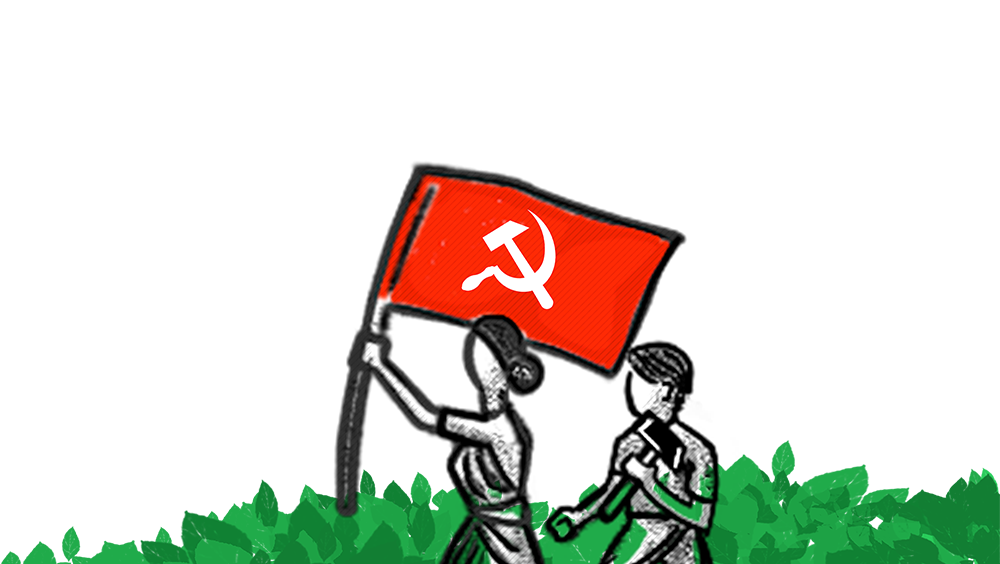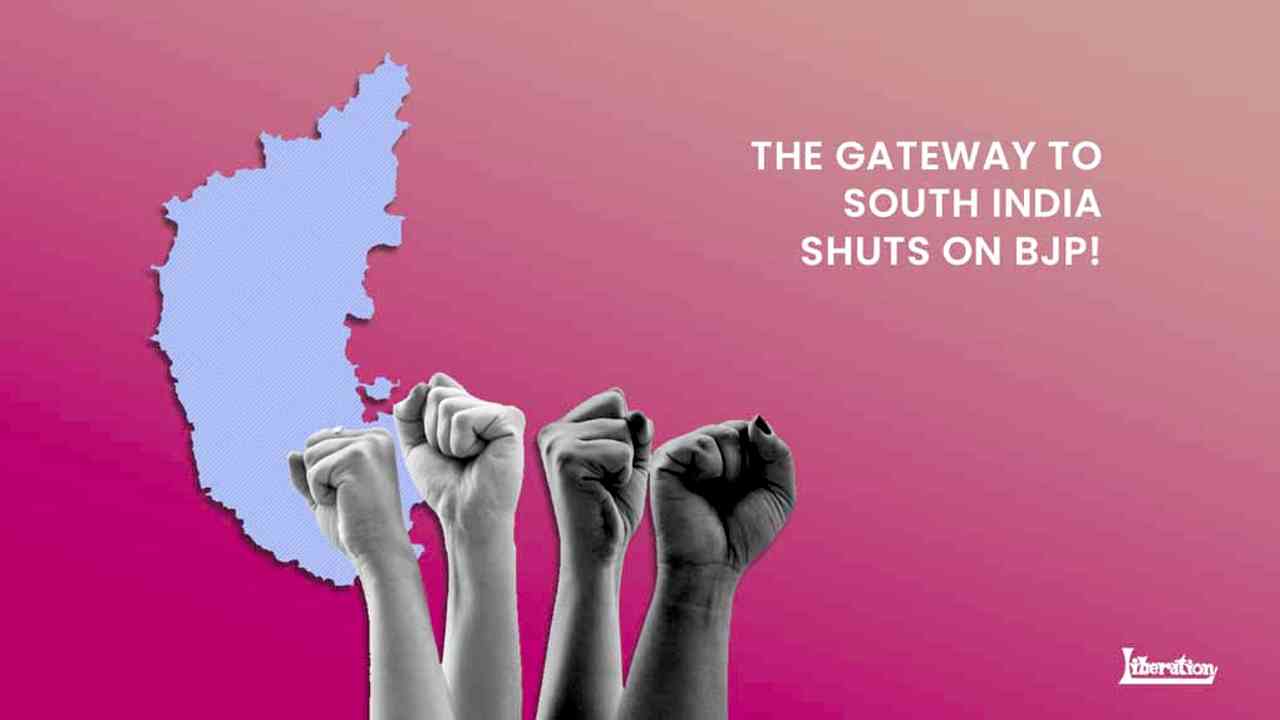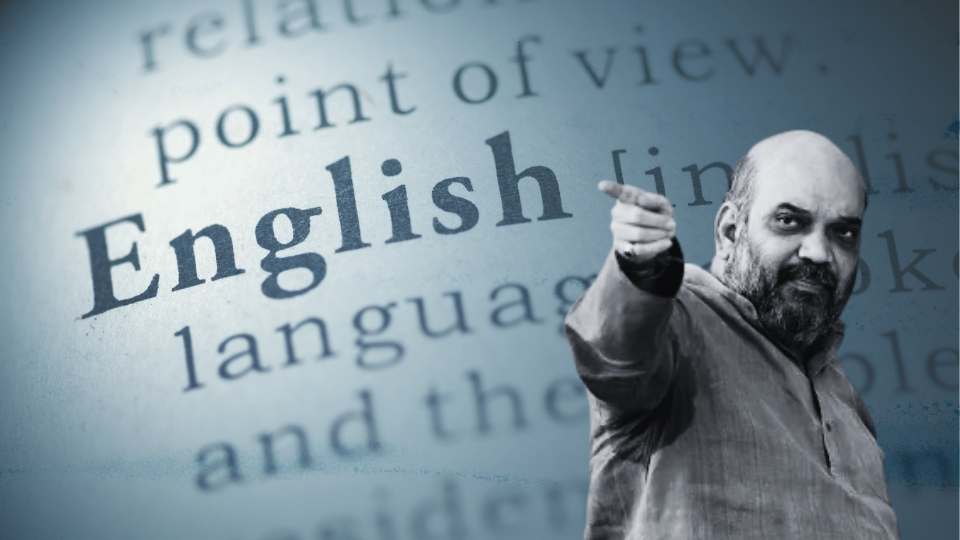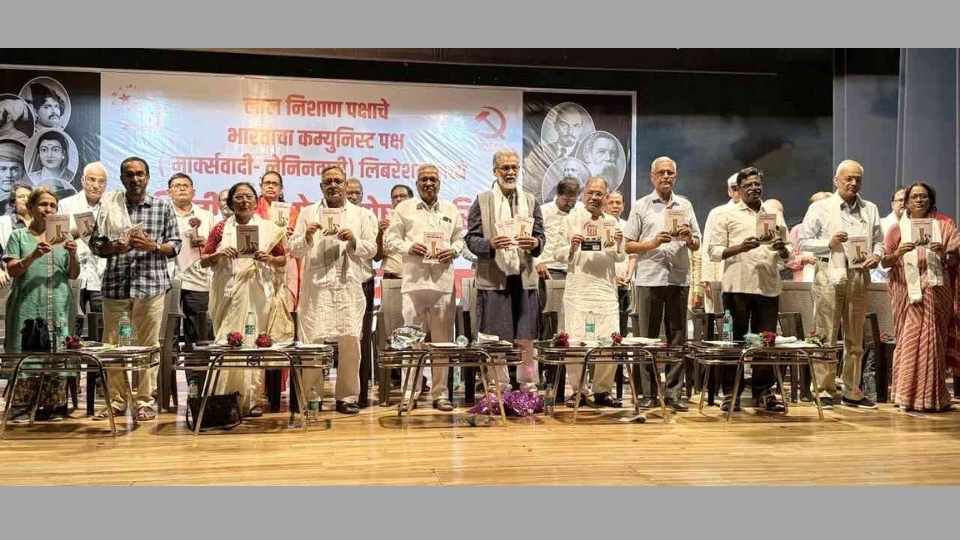In 2018 the BJP had emerged as the largest party and it was only through the corrupt “Operation Kamala” that it could usurp power after a year by engineering splits and purchasing MLAs. The government unabashedly pursued its communal, casteist and corporate agenda. Indeed the legacy of this BJP rule is unprecedented corruption, rising prices and cost of living, crumbling infrastructure, anti-farmers and anti-worker laws, skyrocketing unemployment, a crippled state economy reeling from increasing debt, violence against women and their freedom and autonomy, increasing caste discrimination and atrocities, communal disharmony and religious hatred.
The Congress has won 135 seats with 43% vote share, which are both the largest obtained by any party in Karnataka since 1989. In the 2018 elections the Congress had won 80 seats with 38.1% vote share. Karnataka, where the BJP has enjoyed best electoral success in South India, is also the only state in South India which has seen a BJP government. This time around the BJP could win only 66 seats with 36% vote share compared to the 104 seats with 36.2% vote share in the 2018 elections. JDS has won 19 Assembly seats with 13% vote share. In the 2018 elections, the JDS had won 37 seats with 18% vote share. This is its lowest tally since 1999.
Region-wise performance:[1]
The territory of Karnataka is divided into six political sub-regions that differ in terms of social composition, economic attributes, and political history. These are Coastal Karnataka[2], Old Mysore[3], Central Karnataka[4], Kittur Karnataka (Mumbai Karnataka)[5], Kalyana Karnataka (Hyderabad Karnataka)6 and BBMP region. Traditionally these have been the bastions of different parties. While Coastal Karnataka and Central Karnataka are seen as BJP strongholds, Congress is seen to be strong in Hyderabad Karnataka, and the JDS is concentrated in Old Mysuru region. Bengaluru and to a lesser extent Mumbai Karnataka have seen Congress and BJP battle it out for supremacy.
Coastal Karnataka: This is a traditional stronghold of the BJP, where it has enforced its Hindutva agenda on the ground. The BJP has performed strongly, by winning 13 out of the available 19 seats. However, this is 3 seats less than 2018, and its vote share has reduced by 3.1% in this region. Congress has bettered its 2018 performance doubling its number of seats from 3 to 6, while its vote share has increased by 2.8%. While BJP has performed well in this Hindutva stronghold, one cannot ignore that the Congress has bettered its 2018 performance, both in terms of vote share and number of seats won.
Old Mysore: With 64 seats up for grabs, this is a region where the JDS has traditionally performed well. However this time, the JDS has lost almost half the seats it won in 2018, having a reduced tally of 14 seats compared to 26 seats in 2018. Moreover it has lost almost 7% vote share in this region. The Congress has performed well increasing its seat tally from 20 seats in 2018 to 43 seats this time around and its vote share has increased by 6.9%. The BJP, on the other hand, has also increased its vote share by 2.8%, however the seats won by it has reduced from 16 to 5 seats. This is a region where the BJP made a strong pitch, with the Modi roadshow in Mandya as early as March 2023 and several high-profile rallies. The increase in BJP’s vote share is not commensurate with its focus on this region. Moreover BJP failed in its efforts to communalise and polarise the Vokkaliga votebank using the concocted story of Urigowda-Nanjegowda killing of Tipu Sultan, and even its attempt to woo the community with increase reservation quota has failed. Desertions and the battle for dominance between Deve Gowda’s sons, H.D. Kumaraswamy and H.D. Revanna have cost the JDS dearly.
Kittur Karnataka: BJP has traditionally performed well in this region, but this time around it has a reduced seat tally from 30 to 16 seats, while its vote share has dipped by 2.8%. Congress’s vote share has increased by 5.1% in this region, seeing it win 33 of the available 50 Assembly seats in the region, an increase of 16 seats. Clearly, Congress was successful in shaking the BJP’s stronghold in this region, and for the first time in three decades, its vote share is more than 40% in this region.
Central Karnataka: Congress has increased its vote here by a massive 7.5% resulting in increased seats from 4 to 15, while the BJP has won 6 seats, losing 10 seats and 4.9% vote share since 2018.
Kalyana Karnataka: Congress has done well in its traditional stronghold increasing its vote share by 4.2% to 46.4% and the number of seats from 21 to 26 seats. The BJP’s vote share has dipped by 3.1% in this region while the number of seats it has won has reduced from 15 to 10 seats. Congress has bettered its performance in this stronghold, which is primarily because of the large concentration of Scheduled Caste voters and the Mallikarjun Kharge factor. Congress has won 26 of the 40 seats in this region, while the BJP won only 10.
Bengaluru region: This is another region where the BJP made a strong pitch particularly relying on Brand Modi through his two-day city-wide roadshow. Like Central Karnataka, this region has seen strong tussle between the Congress and the BJP. This time around, the Congress seat tally has reduced from 15 to 13 seats while the BJP tally has increased from 11 to 15 seats. In terms of vote share, BJP has achieved an increase of 5.3% while the Congress too increased its vote share by 1%. JD(S) has lost both the seats it won in 2018.
Reserved constituencies:
Karnataka has 51 reserved constituencies – 36 for Scheduled Castes and 15 for Scheduled Tribes. In the Scheduled Castes reserved constituencies, BJP won 12 seats (down from 16 seats in 2018), while the Congress improved its tally from 12 to 21 seats, and the JDS picked up the 3 seats. The Congress swept the Scheduled Tribes reserved constituencies, picking up 14 seats (in 2018 it had won 8) with the JDS winning the remaining 1 seat. The BJP failed to win even a single seat reserved for the Scheduled Tribes and its tallest ST leader in the State, Minister for Transport and ST Welfare, B. Sriramulu, was defeated in Ballari rural constituency.
This comprehensive defeat is despite the decision of the Bommai government to increase the reservation quota for Scheduled castes from 15% to 17% and that for Scheduled Tribes from 3% to 7%. However, these were seen as election gimmicks since the approval from the Union Government was not given. Similarly the decision on internal reservations in Scheduled Castes too seems to have backfired, since it was opposed by many Scheduled Caste communities, while those communities benefitting from it saw this as a political gimmick since the Union government was yet to sanction the same.
Clearly, BJP’s experiment of meddling with reservation quota has failed to offset the dissatisfaction among the SC/ST communities, who continue to languish at the bottom of the social and economic spectrum.
Women Candidates:
In the 16th Karnataka assembly elections of 2023, 10 women candidates, including 1 Muslim, were elected, surpassing the previous Vidhan Sabha’s count of nine. This is the highest tally since 1989.
Of the women who won this time, 4 each are from Congress and BJP, and 1 from JDS and 1 Independent. As many as 185 women contested in this election out of the total of 2613 candidates. BJP and Congress had fielded 12 and 11 women candidates respectively.
Minority Candidates:
There will be 9 MLAs from the Muslim community and 1 Christian in the Assembly.
Congress had handed tickets to 15 Muslim candidates and nine of them emerged victorious. The JD(S) fielded 23 Muslim candidates, but none could secure a victory. Kaneez Fatima, who won in Gulbarga North constituency was the lone Muslim woman candidate fielded by the Congress.
The Assembly had 9 Muslims in 2008, which went up to 11 in 2013 (nine from Congress and two from JD(S). The highest number of Muslims elected, 16, was in 1978, while the lowest was two under Ramakrishna Hegde’s chief ministership in 1983.
Important takeaways
Class matters: The scale of Congress’s victory, both in terms of seats won and vote share, suggests that it is not only its traditional base that voted for it, but poorer voters from other castes too have backed the party in these elections. Caste is a major factor in deciding the electoral prospects of the three major parties, however, as these elections have shown, it is not the sole defining factor. Traditionally, BJP has the predominant support of the upper castes and the Lingayats, while AHINDA is the assortment of caste behind the Congress, and the JDS has the backing of the Vokkaligas. Despite this, two exit polls - India Today-Axis My India and Eedina, an alternative media group in Karnataka - confirm that economic considerations had a telling influence on voters' decisions. The Lokniti-CSDS post-poll survey data revealed that unemployment was the biggest voting issue for voters in the State followed by poverty and price rise. The emergence of a class coalition transcending traditional caste boundaries is a distinctive factor in the Karnataka assembly elections. Thus, BJP’s endeavour to communalise the caste matrix while disregarding the severe economic distress faced by the people, has come a cropper.
Setback to Hindutva: BJP entered this elections with the knowledge of the anti-incumbency factor and sought to counter this with Hindutva and the Modi blitz – these were also sought to override the caste equations and coalitions. To this end, BJP cast aside several strong Lingayat leaders including Yeddiyurappa and gave tickets to as many as 75 new contestants from the RSS stables. The BJP, in its manifesto, promised to implement a uniform civil code (UCC) in Karnataka, introduce a national register of citizens (NRC), and set up a special police unit to probe religious fundamentalism. It also promised three free cooking gas cylinders to all BPL families — one each during the months of “Yugadi”, “Ganesh Chaturthi” and “Deepavali”. On the other hand, Congress went on the offensive against communal politics; its manifesto titled, “Sarva Janangada Shanthiya Thota” i.e. “Peaceful garden of all communities”, promised action against any organisation that breaks the law, spreads religious hatred, religious bigotry and communal violence and went on to name the Bajrang Dal.
When the manifesto was released, a media frenzy was created over this. Modi included, BJP leaders invoked Bajrang Bali’s name in every rally, a call was given for chanting of the Hanuman Chalisa on 9th May, and efforts were made to equate the Bajrang Dal with Bajrang Bali. All of this failed, and despite many questioning the wisdom of this decision, and also claiming that there was a conspiracy in its inclusion in the manifesto, Congress stuck to its decision. The efforts at remodelling the caste matrix through social engineering came a cropper, as did Hindutva and the Modi blitz. The emphasis on “double engine” government, lack of state-centric issues, and handing over of the State to Modi, Yogi, etc. also offended regional pride and aspirations. BJP was proven wrong in believing that blindly implementing its Gujarat/UP/Assam model i.e. deploying Hindutva to trump caste coalitions and anti-incumbency. Is this election a referendum on Hindutva or hate politics? Perhaps now, but it is definitely a setback to the Hindutva agenda. BJP’s vote share/number of seats have reduced in coastal Karnataka, where it has put in decades of work to communally polarise the region. Significantly, two of the most prominent faces of the Hindutva brand of politics lost in these elections. CT Ravi, BJP National Secretary, and at the forefront of the campaign demanding that Baba Budhangiri be declared a Hindu shrine, lost in Chikkamagalur. Primary and Secondary Education minister BC Nagesh, instrumental in enforcing the hijab ban, lost the election from Tiptur.
The aura of invincibility of brand Modi has worn off: Much hype has been created around Modi, as the BJP’s most reliable election campaigner and an aura of invincibility has been consciously cultivated in this regard. This election saw the BJP deploy Modi as the focal point of BJP’s campaign. Every aspect of the election campaign was a packaging of Modi from the rallies to the roadshows. Modi, of course, made this all about himself, diving deep into victimhood alleging that he was abused 91 times, which the Congress lampooned as weak "Cry PM". Modi’s two-day roadshow in Bengaluru with its metre-by-metre live media coverage was meant to be the master-stroke to turn the elections in favour of the BJP. However, this gamble failed, and even Modi’s deep personal involvement did little to alter BJP’s fate. Two indicators point to its abject failure. Firstly, the voter turnout in Bengaluru was poor. Secondly, there was no major bump in the number of seats won or vote share. In fact, in Bengaluru region if BJP’s vote share increased by 5%, Congress also increased its vote share by 1%. The seats won by the BJP increased from 11 to 15 (including those who shifted to the BJP in 2022), however, BJP lost the Govindarajanagar seat to Congress and indulged in serious malpractice to steal the Jayanagar seat. The message is clear - Modi alone is not enough to win elections!
Role of Civil society: One of the compelling developments impacting the election outcome has been the role played by civil society organisations, particularly “Bahutva Karnataka” and “Eddelu Karnataka”. Perhaps for the first time in its history, Karnataka has experienced non-Party organisations playing such active role during elections urging the people to reject the divisive communal anti-people BJP.
Bahutva Karnataka (Plural Karnataka), a 2-year old broad coalition fighting for communal harmony, released sector-wise report cards[7] exposing the abject failures of the BJP government. These report cards were used by other civil society groups to make instagram posts, pamphlets and websites which give information to voters.
Another important initiative was “Eddelu Karnataka” (Wake up Karnataka), which was formed once elections were announced, by numerous progressive thinkers, litterateurs, civil society activists and civil society groups from across the State, under the leadership of intellectuals including Devanoor Mahadeva, Rehmat Tarikere, Du Saraswati and others. This initiative was embraced by non-Party forces eager to ensure the electoral defeat of BJP. Among other interventions, Eddelu Karnataka took out voter enrolment drives, held seminars and press meets across the state to inform people about the failures of BJP government and issued on a daily basis, posters and videos for social media circulation. Pamphlets highlighting the mis-governance and atrocities of the BJP government were printed and distributed in lakhs.
Other civil society formations which were active during this time include “Slum Janandolana Karnataka”, “Samyukta Horata”, the coalition of farmers, Dalit and worker organisations, and “Campaign against Hate Speech”, all of whom, in their way, helped shape public opinion against the anti-people policies of the BJP.
Perhaps the biggest initiative though came from the Dalit organisations. Splintered into scores of factions, after many years, these factions came together and held a massive convention on 6th December, 2022, in which thousands of people participated, and in which they called for total opposition to communal forces, a euphemism for BJP. This was instrumental in reversing the trend of BJP making inroads into the Dalit vote base, and consolidation of the Dalit vote behind the Congress.
Election Commission of India: ECI functioned in its characteristic partisan manner with which it has now come to be associated. No action was taken against the blatant violations of the Representation of People Act and Model Code of Conduct by Modi and the BJP. Hate speeches and calls for votes on religious lines were turned a blind eye to, as also the two-day show by Modi which was marred by violations and illegalities.
Performance of the Left Parties: Despite efforts to reach an understanding, there was no consensus amongst the Left parties leading to the CPIM, CPI, SUCI and CPIML declaring their candidates for a handful of seats, including some seats where there will be a “friendly contest”. CPIM entered into an “understanding” with the JDS, despite which JDS put up a candidate in KR Puram where CPIM was contesting. Even as the campaigning was in full swing, CPI held a press conference along with Congress leaders at the KPCC office in Bengaluru and declared their support for the Congress in all seats except the 7 seats it was contesting as also two other seats – Bagepalli (CPIM candidate) and Melukote (Sarvodaya Karnataka candidate) seats. CPIML contested in two seats – KR Puram with Com. P.P. Appanna and Kanakagiri with Com Kenchappa – and in remaining seats it supported the Left, secular and democratic parties. Overall, the performance of the Left parties was underwhelming. CPIML secured 227 and 747 votes in KR Puram and Kanakagiri respectively.
Going forward:
The decisive defeat of the BJP accentuates the trend of the BJP losing power in the states. With Karnataka out of its grasp, the BJP has no government in South India cementing its identity as a North Indian party. The significance of this verdict is the implications it holds for the 2024 parliamentary elections. Without doubt a victory for the BJP would have bolstered its belligerence, while knocking the steam out of the opposition parties. Karnataka was the only State in south India where the BJP was in power – the “Gateway to the South”. This door stands shut now and the electoral battle, for now shifts to the upcoming Assembly elections in Rajasthan, Madhya Pradesh, Chhattisgarh and Telengana in the lead up to the parliamentary elections in 2024. These electoral battles against the BJP are part of a long protracted struggle to ensure an emphatic rejection of corporate communal fascism of the Sangh Parivar.
Notes:
1. This section is drawn from the article "Karnataka verdict 2023 analysis: Congress hits BJP, JDS hard in their strongholds" available at https://www.indiatoday.in/elections/karnataka-assembly-polls-2023/story/karnataka-verdict-2023-analysis-congress-hits-bjp-jds-hard-in-their-strongholds-2378937-2023-05-14
2. Uttara Kannada, Udupi and Dakshina Kannada districts
3. Mysuru, Kodagu, Mandya, Hassan, Chamarajanagara, Tumakuru, Chikkaballapura, Kolar and Bengaluru Rural districts
4. Chitradurga, Chikkamagaluru, Shivamogga and Davanagere districts
5. Belagavi, Bagalkote, Hubballi-Dharwad, Vijayapura, Gadag and Haveri districts.
6. Bidar, Yadgir, Raichuru, Koppala, Kalburgi and Ballari districts
7. The report cards were on Education, Healthcare, Key Laws, Nutrition, Agriculture, Federalism, Environment, Labour, Governance, Democracy, Slum Residents Rights, Women’s Rights, Economy, Fiscal Management, Religious Minorities and Rural Development.





